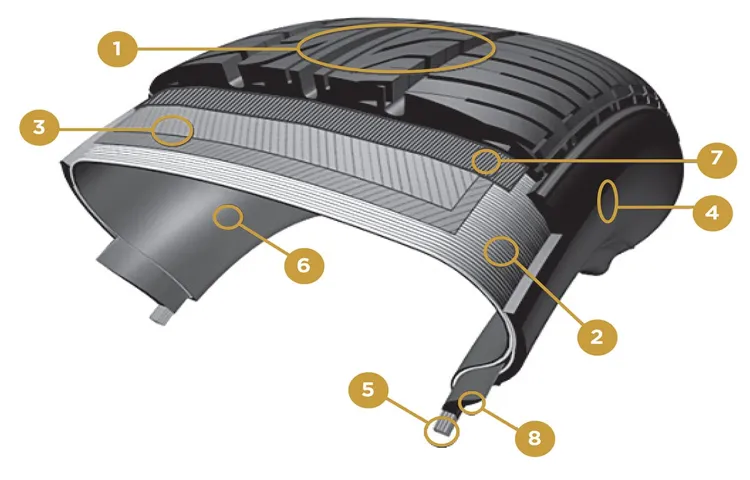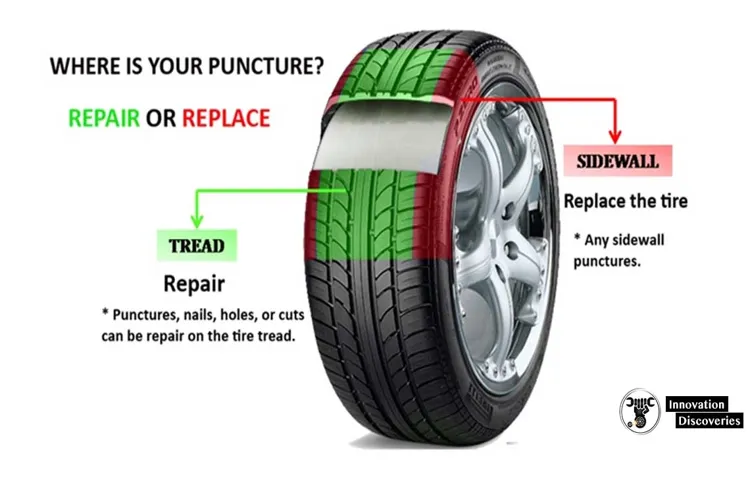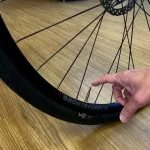If you’re a seasoned driver, you’ve probably heard of run-flat tires, tires that can go for a certain distance even after getting a puncture. However, the burning question is, how far can you actually go on a run-flat tire? Can you continue driving for as long as you want, or do you need to replace the tire immediately? In this blog post, we will answer these questions and more, giving you everything you need to know about run-flat tires. Whether you’re a car enthusiast or a new driver, this post will provide you with essential knowledge about these unique tires and their limits.
So, let’s dive into the world of run-flat tires and explore how far you can go on them!
Table of Contents
What are Run Flat Tires?
Run flat tires are a type of tire that can continue to be operated even after a puncture or other damage that would typically cause a traditional tire to go flat. They are equipped with stiff sidewalls that can temporarily support the weight of the vehicle and keep it from coming into direct contact with the rim. This design allows the driver to continue driving for a period of time even after a flat, giving them the chance to reach a repair shop or safe location.
However, it’s important to keep in mind that run flat tires are not invincible and they can only go so far before becoming completely unusable. The distance that you can go on a run flat tire will depend on a variety of factors including the specific tire model, the speed and weight of your vehicle, and the nature of the damage. It’s generally recommended that you drive no further than 50 miles on a run flat tire, but it’s always better to err on the side of caution and have the tire replaced as soon as possible.
Explanation and Functionality
Run flat tires are a type of tire that can safely continue to be driven on even after a puncture or a blowout. The functionality of run-flat tires lies in their strong sidewalls, which are designed to bear the weight of the vehicle when there is a loss of air pressure. They are specifically designed to provide additional time and mobility in the event of a tire failure, allowing the driver to either make it to a repair shop or find a safer location to replace the tire.
These tires can prevent accidents by making sure the vehicle stays on the road even if there is a puncture. Run-flat tires come with a host of benefits, including enhanced safety, money savings, and convenience. They can eliminate the need for a spare tire and jacks in the car, freeing up space and making them a popular choice in modern vehicles.

Factors That Affect Run Flat Tires
“How far can you go on a run flat tire?” is a common question among drivers. Run flat tires are designed to keep you moving even after a puncture, but how long they last depends on factors such as temperature, speed, and load capacity. In general, run flat tires can travel up to 50 miles at a speed of 50 mph, which should give you enough time to safely reach a nearby tire shop or service station.
However, if you drive too fast or too far on a flat tire, you risk damaging the tire beyond repair or even damaging your vehicle’s suspension or other components. So, while run flat tires are convenient and can help you avoid a roadside emergency, it’s always best to get your tire inspected or replaced as soon as possible to ensure your safety on the road.
Type of Vehicle
Run flat tires have become a popular choice in recent years, especially for individuals who drive high-performance vehicles or commute long distances. However, it’s essential to understand that several factors can affect the performance and longevity of these tires. One of the most significant factors is the type of vehicle you drive.
Heavy or large vehicles, such as SUVs or trucks, can put additional strain on run flat tires, causing them to wear out more quickly than on smaller, lighter vehicles. Additionally, the type of suspension system your vehicle has can also impact the effectiveness of run flat tires. Vehicles with stiff or sport-tuned suspensions may cause more vibration or jarring, making it harder for the tire to absorb impact and leading to a shorter lifespan.
Therefore, when selecting run flat tires, it’s important to consider the type of vehicle you drive, its weight, and suspension type to ensure you get the most out of your investment.
Type of Run Flat Tire
When it comes to run flat tires, there are different types to choose from, but their performance will largely depend on a few factors. One of the factors that affect run flat tires is the type of rubber used in their construction. Generally, run flat tires have a stiffer sidewall than regular tires, which is made possible by using a specialized rubber compound.
This enables the tire to support the vehicle even after a puncture, thereby preventing a sudden loss of control. Another factor that affects run flat tires is the vehicle’s weight and driving speed. The heavier the vehicle and the faster it travels, the more strain it puts on the tires and the more heat it generates.
This can affect the tire’s overall durability. Other factors to consider when choosing run flat tires include the size, tread pattern, and brand. To ensure optimal performance, it’s important to choose the right type of run flat tire for your vehicle and driving needs.
Tire Pressure
When it comes to run-flat tires, maintaining the correct tire pressure is crucial for optimal performance and safety. However, there are several factors that can affect the tire pressure and overall function of run-flat tires. For instance, changes in temperature can cause the pressure to fluctuate, making it important to monitor the pressure regularly.
Another factor is the weight of the vehicle, which can impact the tire pressure and potentially lead to premature wear and tear. Additionally, driving style and road conditions can affect the pressure and lifespan of run-flat tires. It’s important to consider these different elements and take the necessary precautions to ensure the longevity and reliability of your run-flat tires, such as scheduling regular inspections and keeping an eye on tire pressure levels.
By doing so, you can enjoy a smooth and safe ride, even if you experience a flat tire. So, don’t forget to keep an eye on your tire pressure and make any necessary adjustments as needed.
Speed and Distance
When it comes to run flat tires, there are several factors that can affect their performance, including speed and distance. Higher speeds can cause more heat to build up in the tire, which can lead to damage or failure. Additionally, traveling longer distances on run flat tires can also impact their durability and lifespan.
Other factors that can impact run flat tire performance include the vehicle’s weight, road conditions, and driving habits. It’s important to regularly inspect and maintain run flat tires to ensure they are functioning properly and to avoid unexpected flat tires on the road.
How Far Can You Drive on a Run Flat Tire?
If you’ve ever experienced a flat tire while driving, you know just how stressful it can be. But what about a run flat tire? How far can you go on one of those? The answer, unfortunately, isn’t a clear one, as it can vary depending on factors like the type of tire, the speed you’re driving, and the weight of your vehicle. Generally, you can expect to travel up to 50 miles on a run flat tire, but this is not a hard and fast rule.
It’s important to remember that run flat tires are designed as a temporary solution to get you off the road safely, and should be replaced as soon as possible. Driving on a run flat tire for too long risks causing damage to not only the tire, but also your vehicle’s suspension and wheel components. It’s best to play it safe and get your tire replaced as soon as possible.
Manufacturer Specs and Recommendations
When it comes to run flat tires, many drivers wonder just how far they can go on them before needing to replace them. The answer, unfortunately, is not cut and dry. It depends on the specific manufacturer specs and recommendations for each tire.
Some run flat tires can be driven up to 50 miles after a puncture, while others may only be safe to drive for a few miles at a much lower speed. It is crucial to refer to the vehicle’s owner manual to determine the exact recommendations for the specific make and model. Pushing a run flat tire beyond its recommended driving distance can lead to further damage to the tire, and even worse, put the driver and passengers’ safety at risk.
Therefore, it’s best to get a tire inspection as soon as possible and avoid driving on a run flat tire for longer than necessary. In general, it’s better to be safe than sorry when it comes to tires and their capabilities on the road.
Real-World Tests and Results
When it comes to run flat tires, one question that always comes up is “How far can you drive on a run flat tire?” Well, the answer to that question isn’t very straightforward. It depends on various factors, such as tire pressure, the type of vehicle, and the road conditions. Generally, run flat tires are designed to allow you to drive safely for up to 50 miles at a speed of 50 mph after getting a flat.
However, this distance and speed can vary based on different manufacturers and models. Some run flat tires can go up to 200 miles, while others can only go up to 20 miles. The best way to determine how far you can drive on a run flat tire is to consult your car manual or the tire manufacturer’s website.
Regardless of the tire’s capacity, it’s essential to get it checked and changed as soon as possible to ensure your safety while driving on the road.
What to Do when You Have a Run Flat Tire?
If you have a run flat tire, it may be tempting to push your luck and keep driving on it. After all, isn’t that the whole point of these special tires that can supposedly keep you going after a puncture? But before you go too far on a run flat tire, you need to consider a few important factors. First of all, how far can you go on a run flat tire? Well, it depends on the specific tire and the situation, but most run flats can only take you about 50 miles at a maximum speed of 50 mph.
Beyond that point, you’re risking serious damage to your tire (and potentially your car) as well as your safety. So, if you do have a run flat, it’s best to get to a repair shop or tire dealer as soon as possible to get it swapped or fixed. Don’t twist your luck by driving too long on a run flat tire because you could be further damaging your car and putting you and your passengers in danger.
Driving Precautions
Driving with a Run Flat tire can be risky, but there are some precautions you can take to minimize the damage. Firstly, slow down and look for a safe place to pull over. It’s essential to know that a Run Flat tire’s main purpose is to enable you to travel a short distance of up to 50 miles at speeds up to 50 mph, allowing you to reach your destination or the nearest tire repair station safely.
Do not continue to drive with a Run Flat tire for longer distances or at high speeds, as this can cause more damage to the vehicle’s wheel rims and other components. Additionally, if you’re not sure whether your car has a Run Flat tire, check the owner’s manual, tire sidewall markings, or consult your mechanic. It’s always better to be safe than sorry.
Remember, following driving precautions when you have a Run Flat tire can prevent further damage and keep you safe on the road.
Repair or Replace?
When faced with a run flat tire, the first question that arises is whether it needs to be repaired or replaced. The answer depends on the extent of the damage and the amount of wear on the tire. In general, if the tire has a minor puncture or damage to the tread, it can be repaired.
However, if the damage is significant or if the tire has been worn down to the point where the tread depth is inadequate, then it should be replaced. It is important to note that run flat tires have a limited lifespan and can only be driven for a certain distance after they have been punctured. Therefore, it is important to inspect run flat tires regularly and replace them as necessary.
Overall, the decision to repair or replace a run flat tire should be based on a thorough assessment of the tire’s condition and the safety implications of driving on a damaged or worn tire.
Conclusion
In conclusion, the answer to “how far can you go on a run flat tire” is about as subjective as asking a Brit how much tea is too much tea. While run flat tires may allow for continued driving after a puncture, the distance you can go will depend on factors such as the speed at which you drive, the severity of the puncture, and the specific make and model of the tire. So, whether you’re pushing the limits of your run flat tires or your tea intake, just remember to enjoy the ride while it lasts and be prepared for whatever comes your way!”
FAQs
What are run flat tires?
Run flat tires are tires that are designed to keep the vehicle running for a limited distance even when the tire is punctured or damaged.
How far can you drive on a run flat tire?
Depending on the tire and the extent of the damage, you may be able to drive up to 50 miles on a run flat tire.
Can I repair a run flat tire?
Repairs to run flat tires are generally discouraged, as the structural integrity of the tire may have been compromised. It’s best to replace the tire as soon as possible.
What are the advantages of run flat tires?
Run flat tires offer the advantage of allowing you to continue driving even after a puncture or damage to the tire, thereby reducing the need for a spare tire.
Can run flat tires be used on any car?
Run flat tires can only be used on vehicles that are designed to accommodate them. It’s important to consult your vehicle’s owner’s manual to determine whether run flat tires are compatible.
How much do run flat tires cost?
Run flat tires are generally more expensive than traditional tires due to their specialized design and technology. The cost can vary depending on the brand and size of the tire.
Are run flat tires worth the investment?
Run flat tires can be a worthwhile investment if you frequently travel long distances or are concerned about the inconvenience of a flat tire. However, they may not be necessary for all drivers.



